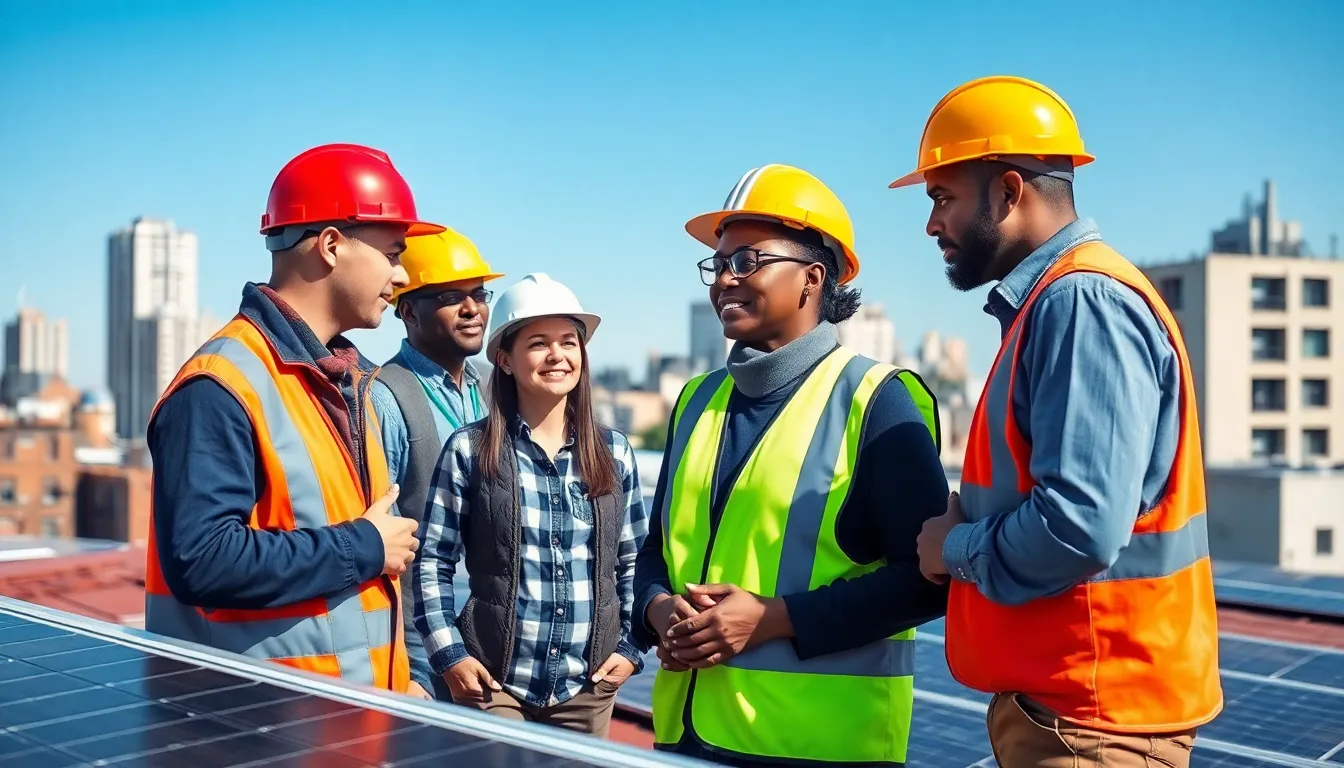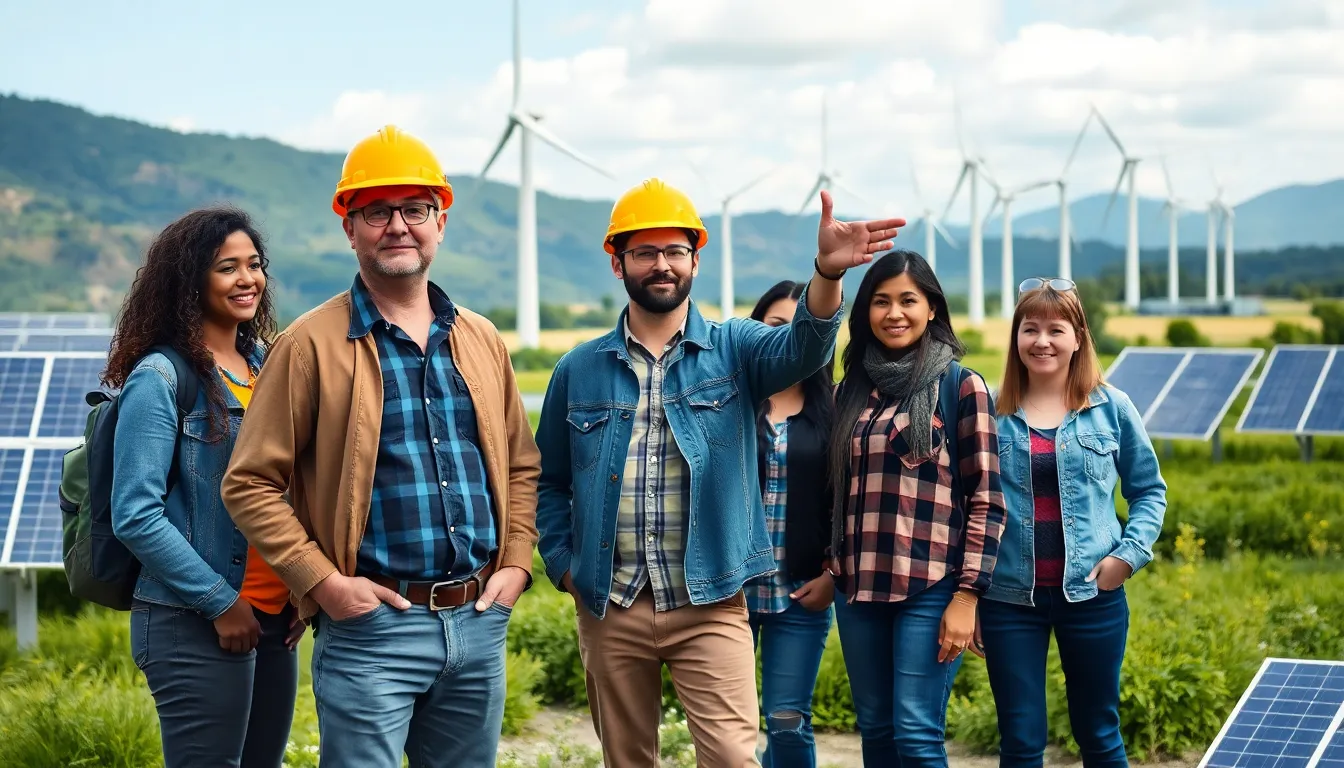In a world where Mother Nature deserves a high-five, green building technology is the superhero we didn’t know we needed. Imagine a construction site where the only thing being demolished is the myth that building can’t be eco-friendly. With innovative materials and energy-efficient designs, these buildings aren’t just structures; they’re statements.
From solar panels that soak up the sun like a beachgoer to rainwater systems that make every drop count, green building tech is turning heads—and saving the planet. It’s not just about saving the environment; it’s about saving money too. Who wouldn’t want lower utility bills while living in a stylish, sustainable space? So buckle up as we dive into the world of green building technology, where eco-consciousness meets modern living, and every brick laid is a step toward a greener future.
Table of Contents
ToggleOverview of Green Building Technology
Green building technology encompasses practices and materials aimed at minimizing environmental impact during construction and throughout a building’s lifecycle. This approach promotes sustainability, optimizing the use of resources while ensuring energy efficiency.
Sustainable materials play a crucial role. Examples include recycled steel, bamboo, and reclaimed wood, each contributing to reduced waste and resource depletion. They eliminate the need for new materials and promote recycling within the industry.
Energy-efficient designs significantly lower energy consumption. Incorporating features such as solar panels, green roofs, and high-performance insulation enhances overall efficiency. Structures equipped with these elements can achieve substantial savings on utility bills, making them financially appealing.
Water conservation measures also define green building technology. Rainwater harvesting systems and low-flow fixtures minimize water usage, addressing scarcity issues in many regions. This strategic implementation leads to a reduction in the overall water footprint of buildings.
Indoor environmental quality remains a priority. Utilizing non-toxic paints, adequate ventilation, and natural lighting improves occupants’ health and comfort. Enhanced air quality directly influences overall well-being, making such practices integral to building design.
Building certifications, such as LEED (Leadership in Energy and Environmental Design) and BREEAM (Building Research Establishment Environmental Assessment Method), set benchmarks for sustainable building practices. These certifications provide clear guidelines and motivate developers to adopt greener methods.
Green building technology integrates advanced materials and innovative design with the overarching goal of promoting environmental and human health. Each project represents a step toward achieving a sustainable future, reducing environmental burdens while providing economic benefits.
Benefits of Green Building Technology
Green building technology offers numerous advantages that greatly enhance sustainability. The benefits span environmental effects and economic gains.
Environmental Impact
Reducing carbon footprints stands as a primary benefit of green building technology. Buildings designed with eco-friendly materials, like recycled steel and bamboo, significantly cut down on resource depletion. Implementing energy-efficient systems minimizes energy consumption and lowers greenhouse gas emissions. Indoor environmental quality improves with non-toxic materials and adequate ventilation, enhancing occupants’ health and comfort. Water conservation measures, such as rainwater harvesting, diminish overall water usage and address scarcity concerns. This combination of strategies contributes to healthier ecosystems while promoting sustainable development.
Economic Advantages
Investing in green building technology leads to substantial economic benefits. Lower utility bills enhance financial savings due to energy-efficient designs and renewable energy sources. Property values often increase with green certifications like LEED and BREEAM, attracting environmentally-conscious buyers. Maintenance costs decrease over time because durable materials and construction methods prolong a building’s lifespan. Additionally, tax incentives and rebates for sustainable projects further encourage investment in green technologies. These economic aspects underscore why adopting green building practices can provide a compelling financial rationale alongside environmental responsibility.
Key Components of Green Building Technology
Green building technology integrates various strategies to enhance sustainability and minimize environmental impact. Key components include energy efficiency and sustainable materials, both vital for creating eco-friendly structures.
Energy Efficiency
Energy efficiency plays a critical role in green building technology. Incorporating solar panels significantly reduces reliance on non-renewable energy sources. Innovative insulation methods decrease heat loss, ensuring interiors remain comfortable while using less energy. Smart lighting systems adjust based on occupancy, optimizing electricity usage. Advanced HVAC systems improve climate control, fostering an energy-efficient environment. Each of these elements contributes to lower utility bills and a reduced carbon footprint.
Sustainable Materials
Sustainable materials serve as the backbone of green building technology. Recycled steel and bamboo significantly minimize resource depletion associated with traditional construction materials. Additionally, reclaimed wood not only reduces waste but also creates unique aesthetic qualities in design. Non-toxic paints and finishes improve indoor air quality, enhancing occupants’ health. Investing in these materials fosters sustainable practices while supporting the economy by reducing landfill contributions and promoting eco-friendly industries.
Challenges in Implementing Green Building Technology
Implementing green building technology presents several challenges that builders and developers face. Understanding these obstacles is crucial for advancing sustainable construction practices.
Cost Barriers
Initial costs often impede the adoption of green building technology. Projects utilizing sustainable materials and energy-efficient systems exhibit higher upfront expenses compared to traditional approaches. For instance, solar panels and high-performance insulation require significant investment. Long-term savings on utility bills may offset these costs, but securing financing remains a challenge for many developers. Economic barriers can deter stakeholders from pursuing eco-friendly projects despite their environmental benefits.
Regulatory Hurdles
Regulatory frameworks frequently pose challenges for green building initiatives. Building codes may not accommodate innovative sustainable practices, creating confusion. Compliance with various local, state, and federal regulations complicates the adoption of green technologies. Certifying bodies like LEED and BREEAM add an additional layer of complexity, requiring developers to navigate detailed guidelines. A lack of clear incentives or support from government entities also hampers progress in adopting green building technology.
Future Trends in Green Building Technology
Innovative materials gain traction in green building technology. Biodegradable composites, for instance, reduce waste and provide sustainable alternatives to traditional options. Automation and smart technologies also transform energy management. Systems featuring IoT devices allow buildings to optimize energy use in real time, significantly lowering utility costs.
Modular construction continues to rise, promoting efficiency and sustainability. Prefabricated components reduce construction time and waste. Another trend involves biophilic design, emphasizing the connection between nature and built environments. This design principle enhances occupant well-being while improving air quality.
Artificial intelligence plays an increasingly significant role in green building technology. AI applications can predict energy consumption patterns, enabling more precise efficiency measures. This technology helps builders and developers create tailored and effective sustainable solutions.
Water efficiency technology sees notable advancements. Smart irrigation systems and greywater recycling methods help manage water usage proactively. Renewable energy systems, including advanced solar panels and wind turbines, support energy resilience and independence. Innovators continually work on improving the efficiency and affordability of these systems.
Finally, regulatory agencies increasingly push for more sustainable practices. Building codes evolve to encourage greener designs and technologies. Government incentives also promote investments in eco-friendly construction. These changes signal a shift towards an integrated approach to sustainability in the construction industry.
Conclusion
Embracing green building technology is essential for a sustainable future. By prioritizing eco-friendly materials and energy-efficient designs, the construction industry can significantly reduce its environmental impact. The benefits extend beyond mere compliance; they include financial savings and improved occupant health.
As innovations continue to emerge, the integration of smart technologies and advanced materials will further enhance the effectiveness of green building practices. While challenges remain, such as cost barriers and regulatory complexities, the momentum toward sustainable construction is undeniable.
Investing in green building technology isn’t just a trend; it’s a commitment to a healthier planet and a more prosperous economy. The journey toward sustainability in construction is ongoing, and every step taken leads to a brighter, greener future.







